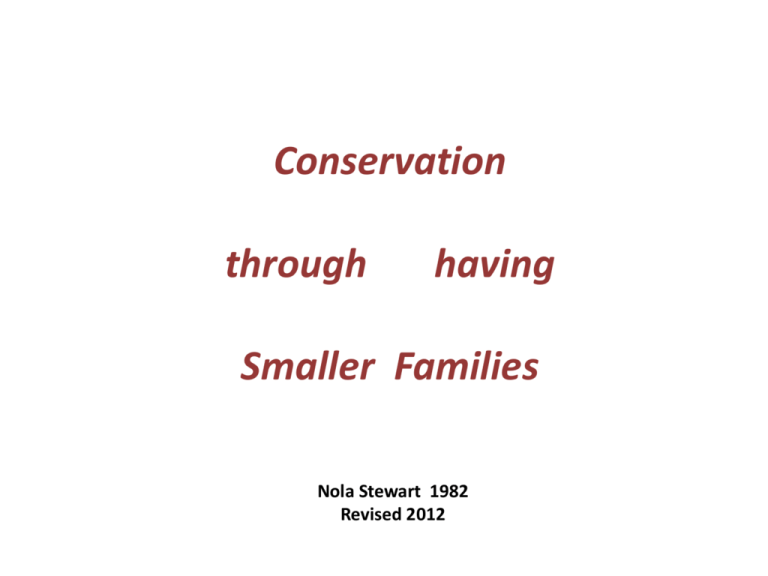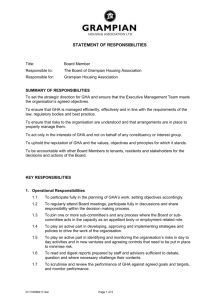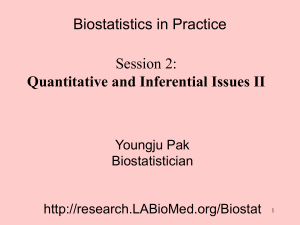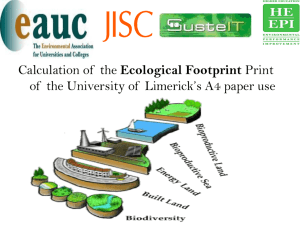Sideshow
advertisement

Conservation through having Smaller Families Nola Stewart 1982 Revised 2012 Part A - MONEY Are there more people on Earth than is helpful for the planet? Most probably ‘Yes’ … World population is increasing Better medical care means that people now live longer Babies which once might have died as infants … …now live to produce families of their own. Each living person has ‘needs’ which the Earth must supply … FOOD, CLOTHING, SHELTER and ENERGY SUPPLIES are the basic needs. Money is usually the key to these things. But where does the money come from? Trade existed before there was money Money was developed as a convenient way of selling … … and buying things But money by itself is useless … … without things to spend it on. And money cannot be circulated unless it is backed by … production from the ground e.g. mining or from the soil, e.g. agriculture or from the sea, e.g. fishing or from the bush, e.g. forestry So, money has to be backed by production. If a government prints money for nothing, it will cause inflation Because there is more money, but not more goods to buy with it. Think about where your money comes from … Some people have jobs in Primary Industry, directly related to the Earth’s provision. The jobs of other people are in Secondary Industry and depend on the raw materials which the Earth supplies. All other jobs are in the Tertiary sector; some in the service industries related to goods produced from the Earth Some people’s salaries come from the taxes which are paid by others. And some people depend on the work of others for their financial support. When we trace our money back to where it came from originally … we will find it is from the productivity of the Earth. And what will we exchange it for? We will spend it on GOODS and SERVICES … … all of which flow from the productivity of the Earth. Mining Agriculture $ Forestry Fisheries Food Shelter $ Clothing Energy supplies All economic activities come at a cost to Earth’s natural ecosystems, as they can be traced back to Primary Industry Each child needs the support of Earth for all its life. It needs some land to be under production to give it food and clothes. Trees will be cut down to provide housing, furniture, books, food packaging. Each child also needs a source of energy, for cooking, lighting and to produce manufactured things. The parents’ income, and later the child’s income, will provide its needs and wants. … But if we trace that income back to its origin, it is the Earth that supports the child … ( … and every child …) every day, 365 days a year, for the whole of its life. Some people have a small amount of financial support, while others have a lot. This means that a SMALL part of Earth supports some people (1% for HALF the population) ...while a comparatively LARGE part supports the rest (99% for the other HALF) . But 75% of Earth’s population is in the underdeveloped areas And only 25% in the developed areas. So it can be worked out that 12 children in an underdeveloped country … … use about as much of the Earth’s resources as one child in a developed country … A reduction of one child in a developed country is equivalent to … … a cutback of 12 children in an underdeveloped country, in saving Earth’s resources. If we choose to have smaller families … … this would help to save the Earth’s resources and its beauty Statistics vary, but it has been said that 2.2 children per family would keep the world’s population … at its present level, given the medical care available to us today. Global footprint Australians use around 7 gha each On average Earth’s population uses 2.7 gha per capita BUT There is only 1.7 gha available GLOBAL HECTARE: An area of one hectare, containing the average amount of productivity of biologically renewable resources such as forests, fish, food crops, fibre, firewood etc., plus uptake of carbon dioxide emissions in a given year. In 1986 we began to overshoot Earth’s renewable resources, just before we reached 5 billion people. We are now using forests, fish, topsoil etc., faster than they can be renewed. We need 1.5 ‘earths.’ It’s important to reduce population because of our consumption. If we each had the consumption of an ant, there would be no problem in having over 7 billion people on the planet. Which is more effective to tackle – POPULATION Or CONSUMPTION? In the 20th century, consumption rose X 10. By 2000 we used ~ 2.7 gha per capita ( In 1900 it would have been ~ 0.27 gha ) In the 20th century, population rose X 4 It was 6 billion in 2000 AD ( In 1900 it was around 1.6 billion) 2 X 3 X 10 Our ecological footprint in global hectares was therefore : 1900 AD - 0.27 X 1,600,000,000 = 432,000,000 gha 2000 AD - 0.27 X 1,600,000,000 X 10 X 4 = 17,280,000,000 gha Which multiplier has the biggest effect? The largest multiplier always does, so for both 1900 and 2000 it is POPULATION at 1,600,000,000 while consumption’s importance relates to the size of our footprint. World population in Nov. 2015 7,400,000,000 Rate of increase = 1.1% Doubling time = 64 years i.e. an additional 7.4 billion What about recycling? In the UK, up to 80 lifetimes of responsible recycling is completely cancelled out by the arrival of one more person via the airport or maternity ward. - Population Matters UK (Hand drawn graph, source: US Census Bureau) Summary To counterbalance the environmental impacts of BETTER MEDICAL CARE and IMPROVED LIVING STANDARDS, we need to first stabilise, then reduce global population in order to save resources and tackle biodiversity loss. This is a response which is reasonable to aim for , given the benefits we receive in modern times better medical care and higher standards of living. Thank you. http://ourworldindata.org/data/growth-and-distribution-of-prosperity/gdp-growthover-the-very-long-run/ See graph of Average world GDP per capita in 1990 International Dollars– Bradford DeLong, at above link. In 1900 World GDP per capita was Int.$ 679 In 2000 World GDP per capita was Int. $6539 (Basis for saying per capita consumption increased X 10) http://ourworldindata.org/data/population-growth-vital-statistics/world-populationgrowth/ Interactive graph showing estimates by different sources of world population at different dates. 1.2 billion around 1850; 1.6 billion lowest estimate around 1900. (Basis for saying world population increased X 4)








